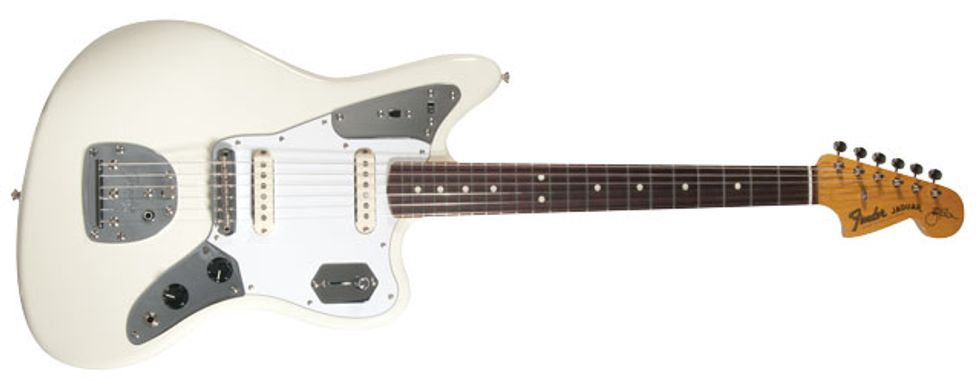Guitar heroes don’t come much more atypical, or antiheroic than Johnny Marr. Apart from hardcore fans, there probably aren’t many who can whistle a Johnny Marr solo. Heck, in his time with the Smiths—still one of the most influential and adored English bands of the last three decades—Marr rarely played a solo, at least in the rip-snortin’, fire-breathing, Jeff Beckian sense. What Marr contributed instead, is a virtual holy text on how to craft a hook and support a song. While there may not be a lot of fleet-fingered fireworks in his oeuvre, licks don’t come much more delicious and clever than the intro to “This Charming Man.” And the menacing, chugging, tremolo-pulsing, Bo Diddley-on-nitrous riff that anchors “How Soon in Now” is heavy enough to make Tony Iommi green with envy.
For Marr and Smiths fans, Fender’s introduction of the Johnny Marr Jaguar might seem odd and enigmatic. As a Smith, Marr was most closely associated with Rickenbackers, Stratocasters, Les Pauls, and Gibson semi-hollows. And in his work as a solo artist and sideman, he was seen with SGs and Telecasters more often than not. But if one thing stays the same about Johnny Marr, it’s that he never stops changing. When he surprised many by joining up with indie-rock superstars Modest Mouse, he threw guitar-spotters a curve by embracing the Jaguar too. And when Fender gave Marr a chance to come up with his own version of the design, he responded with a smart, thoughtful, superbly executed take on this much-misunderstood, and ultra-expressive instrument.
A BeautifullyOdd Bird
When you dig down to the foundation, the
Johnny Marr Jaguar is still a Jaguar. And
that means some folks—generally those
who love technical shredding and highgain,
blooz-rawk wailing—aren’t gonna
get it. But Marr’s refinements of Jaguar
elements that annoy players on the fence
make it a very different and much more
playable guitar.
The body is beautifully balanced, which is one of the unsung strengths of any Jaguar. But in this case, Marr requested some significant comfort-enhancing adjustments— most notably a deeper belly scoop on the back of the guitar and a more contoured chamfer on the front that Marr copied from a mid-’50s Stratocaster.
The guitar has a short-scale neck, which might feel cramped to folks used to standard 25.5" Fender lengths. But Marr had the neck fashioned after a particular 1965 Jaguar in his collection that had a thicker, more substantial profile, and the difference in feel between this Jaguar and most ’60s and reissue editions is notable. It feels a lot more stout, sturdy, and even Les Paul-like at times—giving a sense of leverage that invites big bends and makes chording over the course of a long practice or gig a little less fatiguing.
Always a subject of love-it-or-hate-it scorn and adoration, the bridge and vibrato unit (or “synchronized floating tremolo” as any good Jazzmaster or Jaguar devotee will know it) is considerably improved on the Johnny Marr Jaguar. The bridge is actually pinched from a Mustang—a not-uncommon modification among Jazzmaster and Jaguar players that prefer the smooth and more substantial saddle barrels from the ’Stang. The bridge also has improved mounting bushings that prevent slippage. Meanwhile, the Jaguar’s lengthy tremolo arm now sits more securely in its mounting post, helped by a bushing that prevents the arm from swinging freely so you can keep it close at hand or out of the way.
The most significant change in the Johnny Marr Jaguar is the pickups and the control circuitry. While a small population of players (this reviewer included) found the original Jaguar’s circuitry—with it’s combination of filters and bright and dark potentiometers—wildly versatile, most tend to find it a labyrinth-like hassle. If you’re of the latter camp, you might still find Marr’s improvements fussy, but they are nevertheless more streamlined, effective, and the thing that makes the Johnny Marr Jaguar a completely new evolution of the Jaguar form.
The pickups themselves are Bare Knuckle units modeled after one of Marr’s favorite ’62 Jaguar sets, except both pickups are wound with the same polarity to achieve a more focused sound. It’s the switching potential, however, that really extends the voice of the Johnny Marr Jaguar beyond known Jaguar worlds. The Jaguar’s traditional slider switches are replaced by a 4-position, blade-style switch—a welcome change for any Jag player who has had to duct tape the sliders in place to avoid accidental switching. Positions one through three (bridge, bridge and neck, and neck pickup) will be familiar enough to any Jaguar player, or Telecaster picker for that matter. The fourth position, however, runs the neck and bridge pickup together in series—effectively creating a humbucker from the two pickups and boosting output significantly. The chrome panel on the upper horn, which would ordinarily be home to a Jaguar’s rhythm circuit controls (a circuit switch and volume and tone with darker potentiometer values), now houses the high-pass filter for all pickups that is traditionally located among a standard Jaguar’s trio of slider switches. The upper horn is also home to the treble boost switch for the humbucker setting. Together, they put an assortment of tones at your fingertips that are arguably even more varied and functional that the original circuit.
Jammin’ with Johnny
Jaguars can move between many moods.
And the Johnny Marr may be the moodiest
Jaguar of all. Which means if you play
in a band with a wide-ranging repertoire,
work with a vocalist, or favor music with
plenty of light and shade, this guitar can
cover a lot of ground.
Ratings
Pros:
Super-wide range of warm tones. Stable tuning.
Great vibrato system.
Cons:
Cramped neck for bigger hands. Short scale and
lower output pickups mean less sustain.
Tones:
Playability:
Build:
Value:
Street:
$1,699
Fender
fender.com
Bridge pickup tones are a little less spiky and plonky on the Johnny Marr than your average Jaguar. And while you don’t get considerably more sustain than a standard Jag (perhaps the most common complaint leveled against the breed) the bridge pickup has a wider spectrum, including a little more emphasis on duskier shades that makes single notes sound a little rounder and more pearlescent—giving chords a beautifully smooth character that sounds great through a blackface Fender Deluxe at just about any volume.
The neck pickup is svelte and muscular— not burly or high output like a humbucker by any means, but simultaneously lean and rich in low-end character and able to enrich a band or recorded mix without hogging frequency bandwidth. It also sounds gorgeous with just a touch of pedal compression and delay—enabling you to move from Jim Hall-in-space mellow to David Gilmour soaring with a little manipulation of the tone and volume knobs.
The two pickups together in parallel is a delicious combination—rich with harmonic content that you can feather and massage with a soft touch on the smooth and spongy tremolo. Though it’s the two pickups together in series that’s the revelation, and by switching it to this fourth position, the signal gets much hotter and wider. But the real treat is the expansive, beautifully sustaining low end. At lower to medium volumes, tones from the low E and A strings are warm and simultaneously big, detailed, and harmonically focused with a touch of just-right natural compression. Jazzy explorations and mellow space-rock excursions using a droning 6th string sound warm and sonorous—especially when tuned down to D and C#. And with a blackface Deluxe cranked wide open, the Jag rumbles with a dark, husky growl that takes to everything from light overdrive to beehive fuzz without losing any of its deep harmonic personality.
The Verdict
With its smart and practical electronics,
great pickups, super-musical vibrato
system, and even little touches like shorter
switches that prevent accidental pickup
switching, the Johnny Marr Jaguar is a perfect
example of how an artist with decades
of playing experience across a myriad of
styles can see deeper into a design’s potential,
and help a manufacturer build a better
mousetrap. Marr’s refinements probably
won’t make a difference to a player that’s
determined that a Telecaster or Stratocaster
is the height of functionality and tone
purity. And some Jaguar purists are bound
to cry foul. But for the player that can
approach each and every guitar as a blank
slate and relishes every guitar’s potential as
an expressive tool, the Johnny Marr Jaguar
will be a carnival of sonic possibilities.









![Rig Rundown: Russian Circles’ Mike Sullivan [2025]](https://www.premierguitar.com/media-library/youtube.jpg?id=62303631&width=1245&height=700&quality=70&coordinates=0%2C0%2C0%2C0)

















